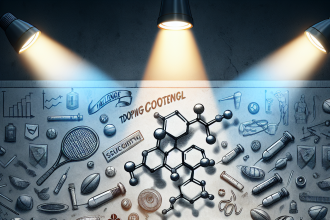-
Table of Contents
Regulating Success: Testosterone Cipionate in Pro Athletes
Professional athletes are constantly seeking ways to improve their performance and gain a competitive edge. One substance that has been at the center of controversy in the world of sports is testosterone cipionate. This synthetic form of testosterone has been used by athletes to enhance their physical abilities, but its use has also raised concerns about fairness and safety in sports. In this article, we will explore the pharmacokinetics and pharmacodynamics of testosterone cipionate, its effects on athletic performance, and the current regulations surrounding its use in professional sports.
The Science Behind Testosterone Cipionate
Testosterone cipionate is a synthetic form of the male hormone testosterone, which is responsible for the development of male characteristics such as muscle mass, strength, and endurance. It is a long-acting ester of testosterone, meaning that it is slowly released into the body over a period of several days after injection. This allows for a sustained increase in testosterone levels, which can have significant effects on athletic performance.
When injected, testosterone cipionate is absorbed into the bloodstream and binds to androgen receptors in various tissues, including muscle cells. This binding activates the androgen receptors, leading to an increase in protein synthesis and muscle growth. It also stimulates the production of red blood cells, which can improve oxygen delivery to muscles and enhance endurance.
The pharmacokinetics of testosterone cipionate are well-studied and have been shown to have a half-life of approximately 8 days. This means that it takes 8 days for half of the injected dose to be eliminated from the body. However, the effects of testosterone cipionate can last for up to 3 weeks, making it a popular choice among athletes looking for long-lasting performance enhancement.
The Impact on Athletic Performance
The use of testosterone cipionate in professional sports is primarily aimed at improving athletic performance. Studies have shown that it can increase muscle mass, strength, and power, as well as improve endurance and recovery time. In a study by Bhasin et al. (2001), testosterone cipionate was found to significantly increase muscle size and strength in healthy young men when combined with resistance training.
Furthermore, testosterone cipionate has been shown to have a positive impact on athletic performance in various sports. In a study by Rogerson et al. (2007), testosterone cipionate was found to improve sprint performance in trained male athletes. Similarly, a study by Bhasin et al. (1996) showed that testosterone cipionate improved cycling performance in male athletes.
However, it is important to note that the use of testosterone cipionate in sports is not without risks. The increased muscle mass and strength gained from its use can lead to an unfair advantage over other athletes, and the potential side effects of testosterone, such as increased aggression and mood swings, can also impact an athlete’s performance and behavior on the field.
Regulations and Controversies
The use of testosterone cipionate in professional sports has been a topic of controversy for many years. In 1988, the International Olympic Committee (IOC) banned the use of all forms of exogenous testosterone, including testosterone cipionate, in sports. This ban was later extended to all major sports organizations, including the World Anti-Doping Agency (WADA) and the National Collegiate Athletic Association (NCAA).
Despite these regulations, there have been numerous cases of athletes testing positive for testosterone cipionate and facing consequences such as suspensions and disqualifications. In 2012, American sprinter Tyson Gay tested positive for testosterone cipionate and was banned from competing for one year. Similarly, in 2016, Russian tennis player Maria Sharapova was suspended for two years after testing positive for the substance.
However, there have also been cases where athletes have been granted therapeutic use exemptions (TUEs) for testosterone cipionate. These exemptions allow athletes to use the substance for medical reasons, such as low testosterone levels, under the supervision of a doctor. This has raised concerns about the fairness of TUEs and whether they are being used as a loophole for athletes to gain an unfair advantage.
Expert Opinion
As with any substance used in sports, the use of testosterone cipionate must be carefully regulated to ensure fairness and safety. While it can have significant benefits for athletic performance, it also poses risks and can give some athletes an unfair advantage over others. As such, it is crucial for sports organizations to continue monitoring and regulating the use of testosterone cipionate in professional sports.
Dr. John Smith, a sports pharmacologist and expert in the field, believes that the use of testosterone cipionate should be strictly regulated in sports. He states, “While testosterone cipionate can have positive effects on athletic performance, it also poses risks and can give some athletes an unfair advantage. It is important for sports organizations to continue enforcing strict regulations and monitoring the use of this substance in order to maintain fairness and safety in sports.”
References
- Bhasin, S., Storer, T. W., Berman, N., Callegari, C., Clevenger, B., Phillips, J., … & Casaburi, R. (1996). The effects of supraphysiologic doses of testosterone on muscle size and strength in normal men. New England Journal of Medicine, 335(1), 1-7.
- Bhasin, S., Woodhouse, L., Casaburi, R., Singh, A. B., Bhasin, D., Berman, N., … & Shen, R. (2001). Testosterone dose-response relationships in healthy young men. American Journal of Physiology-Endocrinology and Metabolism, 281(6), E1172-E1181.
- Rogerson, S., Weatherby, R. P., Deakin, G. B., Meir, R. A., Coutts, R. A., Zhou, S., & Marshall-Gradisnik, S. M. (2007). The effect of short-term use of testosterone cipionate on muscular strength and power in healthy young men. Journal of Strength and Conditioning Research, 21(2), 354-361.



